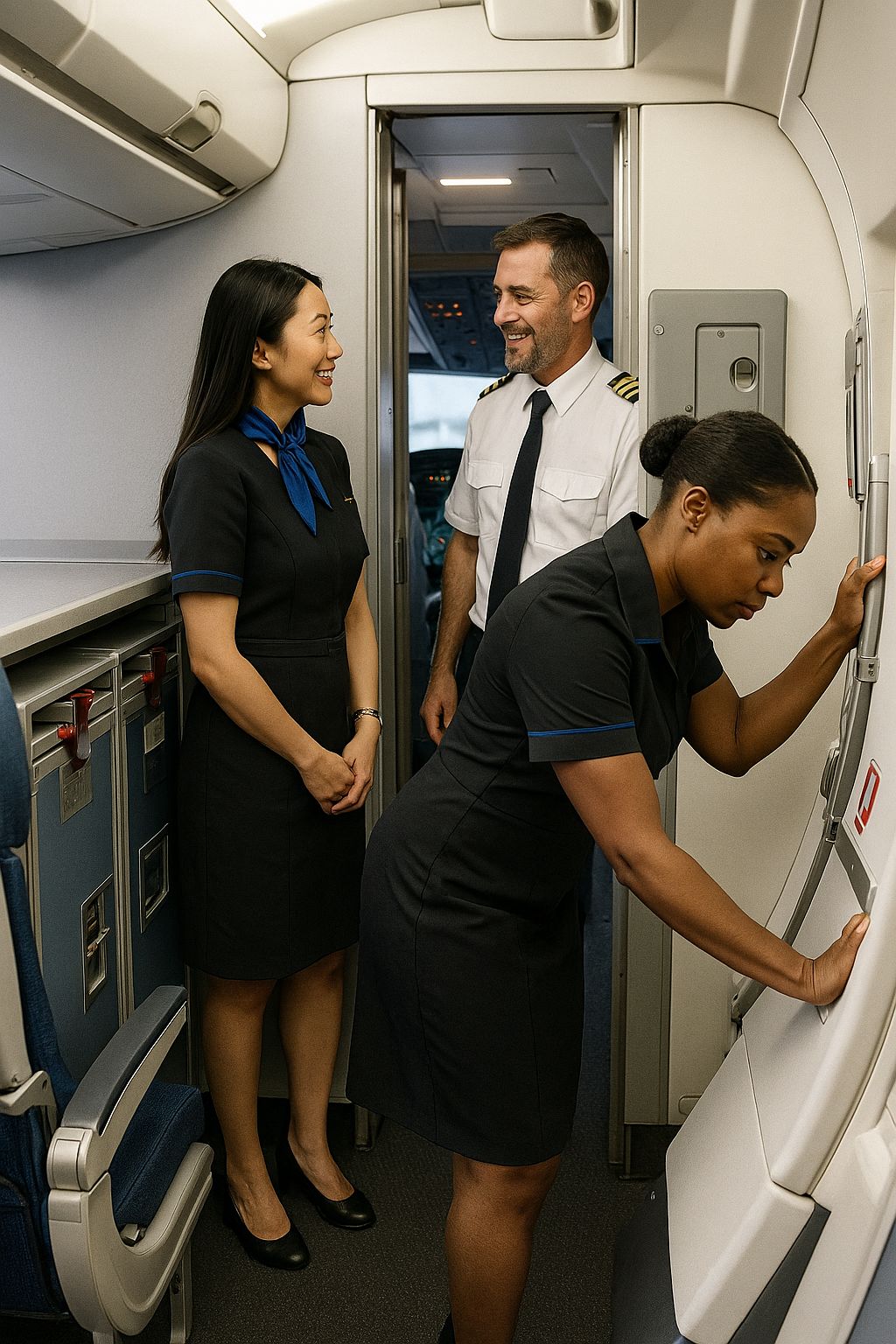Custom eLearning Solutions
for Aviation Teams
Offer effective learning opportunities
Close skill gaps
Establish cost-effective
training
Elevate your Aviation operations with quality custom elearning content.
for the Aviation industry
Microlearning Modules
Bite-sized lessons that deliver focused knowledge quickly and efficiently.
Example:
Short, mobile-friendly lessons help crews and ground teams quickly review essential topics such as ramp safety zones, boarding sequences, cabin service procedures, and basic load considerations. Each 3–7 minute lesson uses visuals and can be tracked, making it ideal for a quick refresher before a flight turn or briefing.
Engaging Scenarios
Interactive stories that let learners practice decision-making in realistic contexts.
Example:
Interactive branching stories replicate real-world decisions, such as handling a weather delay at the gate, reseating families, or coordinating a last-minute equipment change. Different choices lead to different outcomes that affect on-time performance, customer experience, and safety margins, helping learners understand the impact of their decisions.
Tests and Assessments
Quizzes and evaluations that measure understanding and track progress.
Example:
Image-driven quizzes confirm critical knowledge by asking learners to identify marshalling signals, stow equipment correctly, or verify emergency equipment placement. Randomized questions ensure fairness and help demonstrate readiness for recurrent qualifications.
Personalized Learning Paths
Customized content sequences tailored to each learner’s goals and needs.
Example:
Role-specific learning sequences for cabin crew, ramp agents, dispatchers, and maintenance technicians adapt to factors such as station, fleet type, and seniority. Completion records and performance data determine the next module, ensuring that learners focus on the topics that matter most.
Performance Support Chatbots
On-demand digital assistants that provide just-in-time answers and guidance.
Example:
When questions arise during a shift, a virtual assistant provides quick answers about topics such as boarding priorities, minimum requirements for carry-on bins, or references for equipment placement. The chatbot is available within tools like Teams, Slack, or the learning management system, so staff can access information without leaving their workflow.
Online Role-Plays
Simulated conversations or interactions that help learners build real-world skills.
Example:
Online role-play simulations allow staff to practice challenging interactions in a safe environment, such as de-escalating an upset traveler, coordinating with ramp crews during a tight turn, or delivering a clear announcement. Learners can speak or type, receive immediate coaching, and repeat the scenario until they gain confidence.
Compliance Training
Structured programs that ensure employees meet regulatory and organizational standards.
Example:
Compliance training keeps teams up to date on safety, security, and workplace standards using aviation-specific examples. Interactive modules use photo cues and short knowledge checks to ensure that compliance requirements are clear, memorable, and easy to audit.
Situational Simulations
Immersive activities that replicate real-life challenges in a risk-free environment.
Example:
Immersive simulations model the coordination required during aircraft turns, boarding timelines under delay pressure, or cabin service flows during turbulence. Learners make decisions within a limited timeframe and see how their choices influence safety, service quality, and punctuality.
Upskilling Modules
Targeted courses designed to expand knowledge and build new competencies.
Example:
Upskilling modules help employees develop new capabilities such as becoming familiar with a new aircraft fleet, using digital tools for crew communications, or mastering advanced baggage handling techniques. These short, visual courses accumulate into badges, recognizing skill development.
Problem-Solving Activities
Exercises that strengthen critical thinking and practical problem-solving skills.
Example:
Problem-solving activities present case studies that guide teams through decisions such as irregular operations choices, load planning tradeoffs, or cabin service recovery. Learners analyze data snippets, propose actions, and compare their solutions to best-practice outcomes.
Collaborative Experiences
Group learning opportunities that encourage teamwork and knowledge sharing.
Example:
Collaborative experiences bring together gate agents, ramp crews, cabin staff, and operations control center personnel to practice smooth handoffs and contingency planning. Shared digital boards and asynchronous comments ensure that all participants are aligned on the plan.
Games & Gamified Experiences
Play-based learning methods that motivate through competition, rewards, and fun.
Example:
Gamified experiences make training refreshers engaging through friendly competitions such as signal recognition sprints, boarding flow puzzles, and service sequence races. Participants earn points and badges, which help keep participation levels high.
1
Skill Growth
Custom training builds real-world competencies step by step, giving learners the confidence and ability to perform effectively.
2
Employee Engagement
As learners see their skills improving, they become more invested and motivated, deepening participation in the training process.
3
Organizational Readiness
This combination of stronger skills and higher engagement ensures the workforce is prepared, compliant, and aligned with organizational goals.
in the Aviation Industry
40%

Less Time Spent on Training
Online learning requires less than half of the time that would be needed for in-person training.
70%

Efficient Experience-Based Learning
Up to 70% of adult learning occurs through hands-on experiences. Online task simulators allow practicing and making mistakes in safe environments.
94%

Higher Learner Satisfaction
94% of adult learners prefer to study at their own pace and on their own schedule.
of your Aviation staff
AI-Powered Chatbots and Virtual Coaching
These are conversational agents (often built on advanced language models) that can interact with employees in natural language – answering questions, providing feedback, and even coaching in a human-like manner. L&D decision-makers are increasingly adopting these tools to offer on-demand assistance and personalized guidance.

24/7 Learning Assistants
AI chatbots serve as always-available tutors or helpdesk agents for learners. Employees can ask a training chatbot to clarify a concept, provide an example, or troubleshoot a problem at any time. Many companies have integrated such bots into their learning platforms or collaboration apps. According to industry research, virtual assistants and chatbots are now being deployed to handle routine learner queries and provide instant feedback on quizzes or exercises. This immediate support keeps learners from getting stuck and enables more self-directed learning. It also reduces the burden on human instructors or IT support for common questions.
Example:
Agents and crews can ask for process steps or references at any time, such as boarding priorities or equipment checks, and receive accurate, branded answers instantly through their messaging tools.

Feedback and Coaching
Beyond Q&A, AI coaches can give real-time feedback on performance. Modern AI tutors use natural language understanding to evaluate free-form responses and deliver personalized coaching, just like a digital mentor. L&D leaders find these applications instrumental in achieving training goals; surveys show high ROI of using AI chatbots to offer real-time feedback and guidance during learning.
Example:
When staff members practice announcements or service dialogues, AI analyzes clarity, timing, and tone, suggesting clearer wording or better pacing. The tool functions like a personal coach that is available on demand.

Scenario Practice and Role-Play
A cutting-edge use case of AI chatbots is powering immersive role-play simulations. AI characters can simulate realistic dialogues with learners. Users can practice a coaching conversation with an AI-driven avatar that responds dynamically. Many organizations have already implemented this type of learning interaction, enabling learners to practice difficult conversations in a safe, simulated environment and receive instant constructive feedback. The AI can adapt its responses based on what the learner says, creating a tailored scenario and coaching the learner on their choices. This moves training beyond scripted e-learning into interactive learning-by-doing.
Example:
AI-driven avatars take on the roles of passengers, ground partners, or colleagues and react to the learner’s choices in real time. This allows staff to practice de-escalation, coordination, and service recovery in a safe environment.

coaching can help you improve training outcomes.
Automated Assessments and Intelligent Feedback
AI is transforming how companies assess learning and evaluate competencies. Traditional training assessments (quizzes, tests, assignments, etc.) can be labor-intensive to create and grade, and they often provide limited feedback to learners. AI is changing this by enabling more automated, intelligent assessment methods.
Auto-Generated Quizzes and Exams
Using generative AI, L&D teams can automatically create pools of quiz questions, knowledge checks, or even complex case-study exams. Given a training document or video, an AI tool can generate relevant questions to test comprehension. This not only speeds up assessment development but can also produce a wider variety of test items (reducing over-reliance on a few repeat questions). By automating quiz generation, trainers ensure assessments are always fresh and stay aligned with up-to-date content and learning goals.
Example:
When procedures or station notices are updated, AI can generate new question banks in minutes, including image identification, sequencing, and scenario-based items. Subject matter experts then review and approve the questions before they are published.

Automated Grading and Evaluation
Your AI-powered training tool can grade many types of learner responses automatically, far beyond simple multiple-choice scoring. Natural language processing models are capable of evaluating open-ended text responses, short essays, or even code snippets by comparing against expected answers or rubrics. This is particularly useful for large companies that need to assess thousands of learners efficiently and do it in a way that offers personalized feedback and recommendations.
Example:
AI-based evaluation reviews written responses and short demonstration videos to check for key steps and clarity. The system returns consistent scores and feedback at scale, and human reviewers can easily sample and audit the results.

AI-Assisted Feedback and Coaching
Beyond Q&A, AI coaches can give real-time feedback on performance. Modern AI tutors use natural language understanding to evaluate free-form responses and deliver personalized coaching, just like a digital mentor. L&D leaders find these applications instrumental in achieving training goals; surveys show high ROI of using AI chatbots to offer real-time feedback and guidance during learning.
Example:
AI-assisted coaching provides a deeper analysis by assessing voice, timing, and gestures in role-plays or demonstrations. The system highlights strengths and specific moments for improvement with time-stamped markers.

Fairness and Consistency
AI-based assessment can also improve consistency in scoring and reduce human bias in evaluations. Every learner is judged by the same criteria, and AI models (when properly trained and tested) apply the rubric objectively. And, of course, there's always an option to validate AI-produced scores with periodic human review, especially for high-stakes evaluations, to maintain trust and accuracy.
Example:
A standardized set of evaluation criteria combined with AI ensures uniform scoring across stations and fleets, reducing variability and bias. Human sampling remains part of the quality assurance process to maintain trust and oversight.

assessments and intelligent feedback.
Predictive Analytics for Training Impact and ROI
Linking training efforts to business outcomes has long been a challenge for L&D. Today, AI-driven learning analytics are giving organizations new powers to measure and even predict the impact of training on performance metrics. By analyzing large datasets of learning activities and outcomes, AI can uncover patterns that help prove ROI and improve decision-making.
Advanced Learning Analytics
Traditional training metrics (completion rates, test scores, satisfaction surveys) only tell part of the story. AI allows far deeper analysis by correlating learning data with business data. Organizations are deploying predictive analytics that ingest data from Learning Management Systems, HR systems, and operational KPIs to evaluate how training moves the needle on business goals.
Example:
Advanced learning analytics combine training data with key performance indicators such as on-time performance, turn time, safety reports, and customer satisfaction scores. This helps organizations identify which training efforts lead to improvements and where to focus future training.

Predicting Training Needs and Outcomes
AI can not only look backward but also predict future training needs and outcomes. AI-driven analytics can even predict which employees might benefit most from certain training, or who might be at risk of low performance without intervention. This predictive capability helps L&D teams prioritize and tailor their initiatives for maximum impact.
Example:
Before new procedures or fleet changes are implemented, AI analyzes past performance patterns to identify stations or crews that may struggle. This enables proactive preparation to address potential issues before they arise.

Real-Time Dashboards and Reporting
Modern L&D analytics platforms infused with AI provide real-time dashboards that track training effectiveness. These might include sentiment analysis of learner feedback comments, anomaly detection (e.g., identifying if a particular course consistently yields poor post-test results, indicating content issues), and even natural language generation to summarize insights for L&D managers. The goal is to move beyond basic reporting to actionable intelligence.
Example:
Real-time dashboards show readiness by role, station, and fleet, highlight modules that are causing confusion, and summarize insights in plain language so leaders can take action quickly.

Demonstrating ROI
AI-powered analytics capabilities feed into the bigger mandate of proving the value of training. AI helps by directly linking learning metrics to performance metrics. Companies can now estimate the dollar impact of closing a skill gap or predict how improving a certain skill through training will affect key business outcomes. This elevates L&D’s credibility in the eyes of executives.
Example:
Demonstrate the value of training by linking learning activities to operational improvements such as fewer delays, smoother turns, and better customer scores. Reports quantify hours saved and other benefits to support continued investment in training.

can drive your business outcomes.
Major Airlines
- Roll out station-specific training at scale with role-based paths.
- Reduce turn delays by practicing choreography in simulations.
- Link learning to on-time performance and service metrics.
Regional Airlines
- Standardize procedures across remote stations with mobile microlearning.
- Prepare crews for seasonal ops changes with predictive refreshers.
- Ensure recurrent training compliance with clear audit trails.
Airports & Ground Handlers
- Improve safety culture with visual, station-specific modules.
- Cross-train ramp teams for peak flexibility using adaptive paths.
- Track readiness by shift to staff critical roles confidently.
MROs
- Reduce error rates with image-based checks and just-in-time tips.
- Accelerate onboarding on new fleet types with structured pathways.
- Demonstrate compliance with consistent assessments and records.
FBOs & Charter Operators
- Train ground and cabin teams on premium service rituals and safety.
- Use role-plays to polish client interactions and discretion.
- Align scattered bases with mobile, offline-capable modules.
Air Cargo Carriers
- Strengthen load and securement practices with simulations.
- Reduce handling incidents through image-based ID and checks.
- Correlate training to on-time departures and damage rates.
Helicopter Operators
- Adapt training for unique operations and landing sites.
- Standardize safety briefings and ground coordination procedures.
- Track currency and competencies across pilots and crew.
Flight Schools & Training Centers
- Blend eLearning with sim sessions using auto-generated quizzes.
- Provide consistent, rubric-based grading with AI assistance.
- Offer analytics on progress toward checkride milestones.
Aviation OEMs & Suppliers
- Provide product and maintenance training to customers at scale.
- Localize content for global fleets and languages.
- Demonstrate training impact during entry-into-service programs.
Catering & Inflight Services
- Standardize galley setups and service pacing through microlearning.
- Practice service recovery interactions with role-plays.
- Link training to uplift accuracy and waste reduction.
This case study profiles an Airports & Ground Handlers operation that implemented Situational Simulations—supported by the Cluelabs xAPI Learning Record Store—to track readiness by shift and staff critical roles with confidence. Facing volatile demand, safety-critical workflows, and high turnover, the team co-designed role-based scenarios mapped to competencies and connected performance data to rostering to surface coverage and gaps. The approach reduced errors and rework, accelerated time to proficiency, and provided audit-ready proof of skill, offering a repeatable model for aviation leaders and L&D teams seeking measurable impact.
This case study shows how an aviation OEM-and-supplier operation implemented Scenario Practice and Role-Play, instrumented with xAPI and the Cluelabs Learning Record Store, to align practice with real entry-into-service events. By capturing decisions, escalations, and time-to-resolution across simulations and coached role-plays, the team linked training to KPIs such as first-time-fix rate, defect-closure lead time, and safety checks, delivering auditable proof of readiness during EIS. Executives and L&D teams will find a practical blueprint for scaling the approach across programs and regions.
This case study profiles a regional airline that implemented Problem-Solving Activities delivered through mobile microlearning to standardize procedures across remote stations. Supported by the Cluelabs xAPI Learning Record Store to capture learner choices and reveal drift, the program produced tighter SOP adherence, faster onboarding, and fewer operational deviations, while giving leaders audit-ready visibility and station-level coaching insights.
